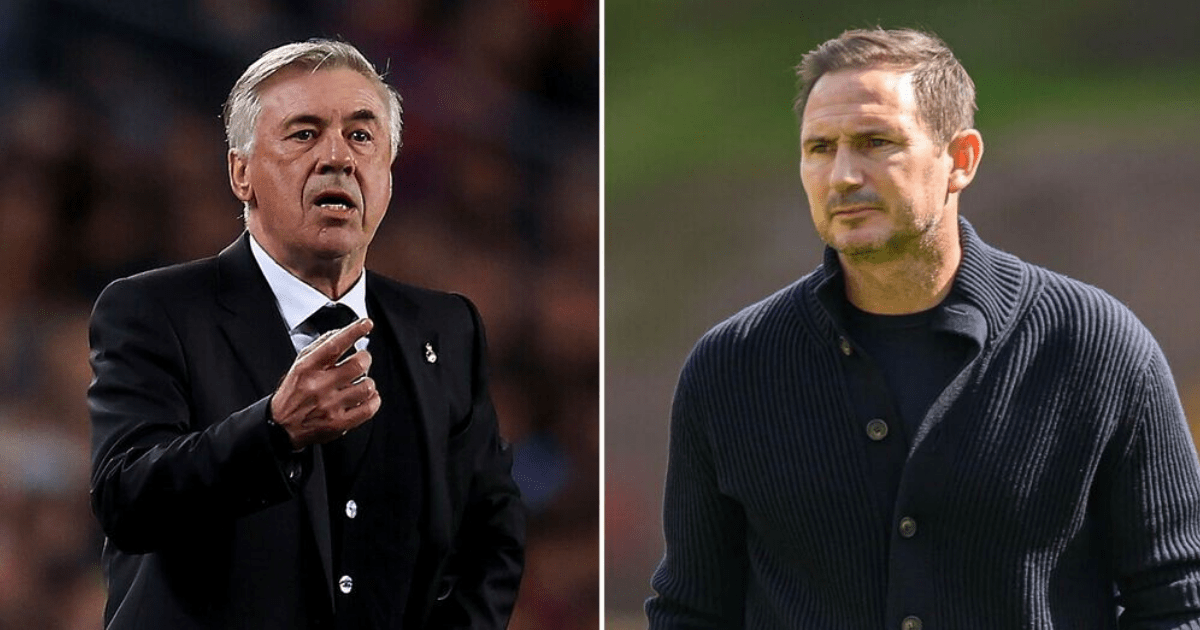PART two of a colossal round of fixtures in the UEFA Champions League kicks off on Wednesday night as Premier League stooges Chelsea take on the European champions Real Madrid.
It’s been a hectic two weeks for the Blues and everyone involved.
Carlo Ancelotti comes up against his former player Frank Lampard
Having decided to part ways with Todd Boehly’s apostle Graham Potter, the Blues made the eyebrow-raising decision to appoint Frank Lampard as the new head coach for the second time in four years.
The club legend will take the reins merely on an interim basis but already got off to a horrific start on Saturday as Chelsea were put to the sword by Wolves on his second debut.
However, Lampard’s success won’t be measured in the league.
Supporters are pinning all their hopes on him giving this season purpose by lifting the grandest prize in club football.
Unfortunately for Lampard, his former professor Carlo Ancelotti stands in his way and the Italian certainly still has one more lesson in him for Frank.
Chelsea are wounded gazelles right now and Real Madrid are the hungriest lions in the jungle.
This could make for a grim spectacle.
Familiar face with a familiar shape
Early into Graham Potter’s tenure at Stamford Bridge, the former Brighton coach opted to move away from Tuchel’s back three to a 4-2-3-1.
CASINO SPECIAL – BEST ONLINE CASINOS FOR 2023
However, in away games, particularly in Europe, Potter reverted back to a 3-4-3 to add a little more defensive solidity.
Nevertheless, after a string of games where Chelsea struggled to find the net, the Blues’ boss stuck with his 3-4-3 in all competitions, home and away.
Unfortunately, this didn’t have the desired effect on results.
Chelsea couldn’t buy a win and so Potter moved back to the 4-2-3-1 before switching one final time to a back three at the end of his reign whilst clutching at straws.
This inconsistent formation selection was cited as one of the 47-year-old’s downfalls in West London.
Upon taking the reins this past week, Lampard opted to change to a 4-3-3 as Chelsea travelled to Wolves, adding further discomfort to the side’s tactical blueprint – whatever that may be.
Enzo Fernandez is the key man in the Chelsea midfield
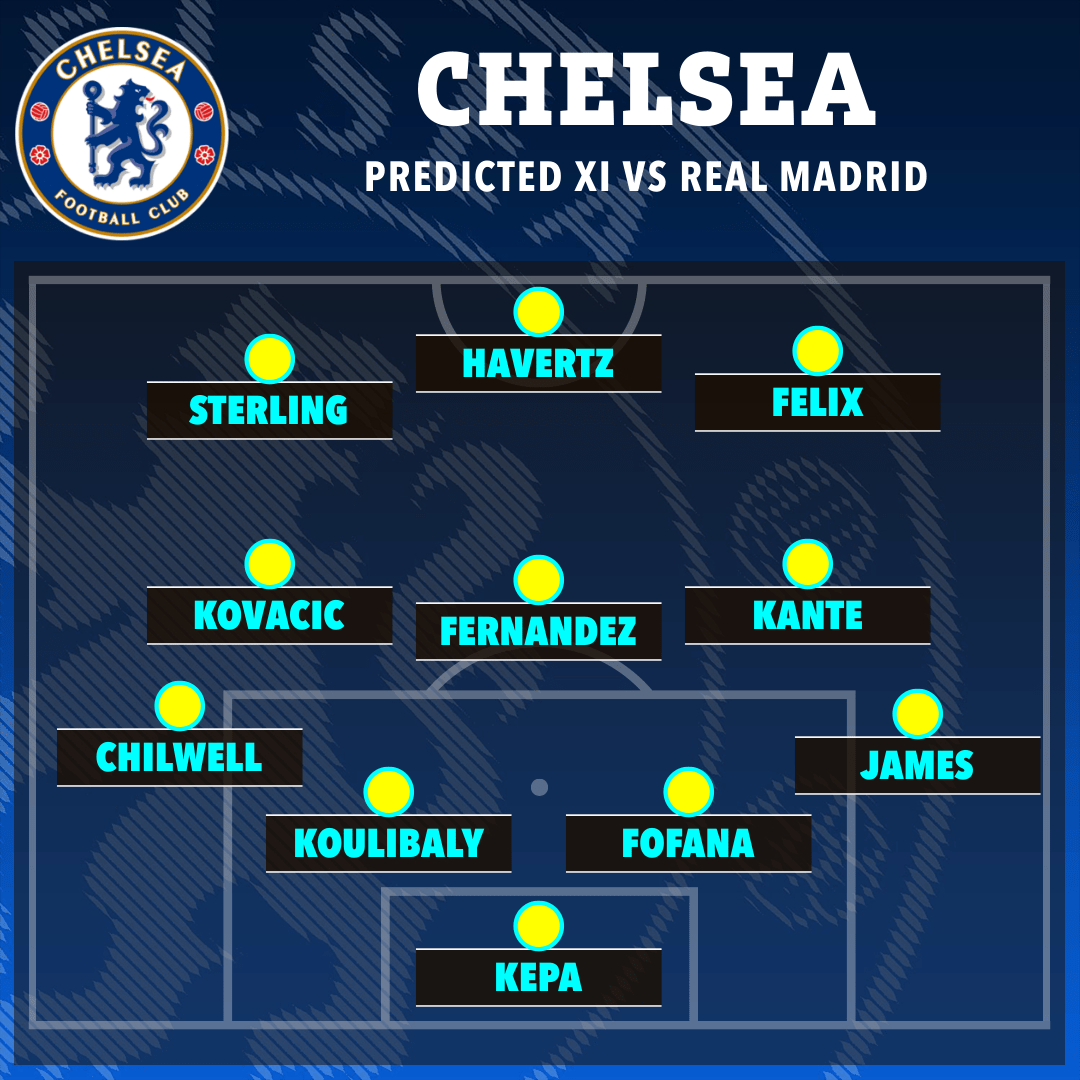 Lampard is expected to keep to his regular 4-3-3 formation for Real Madrid
Lampard is expected to keep to his regular 4-3-3 formation for Real Madrid
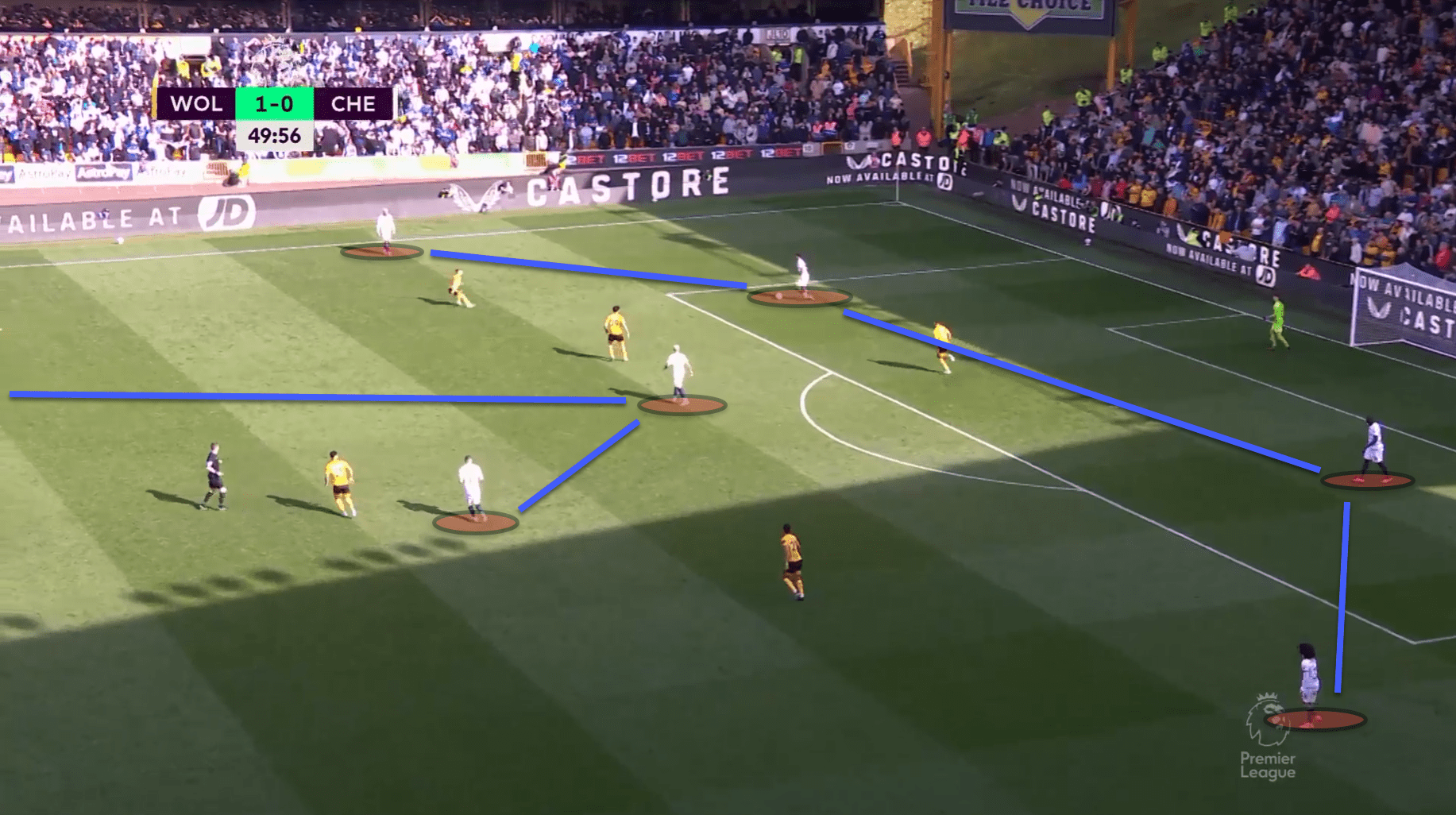 Enzo Fernandez operated as the No6 in front of the back four, screening from left to right looking for passes to his feet, while Conor Gallagher and Mateo Kovacic were positioned further forward.
Enzo Fernandez operated as the No6 in front of the back four, screening from left to right looking for passes to his feet, while Conor Gallagher and Mateo Kovacic were positioned further forward.
Lampard has always been an advocate for the 4-3-3, using the formation at Derby, Everton and even during his first stint with Chelsea.
The club legend hoped that using a 4-3-3 and having more offensive players on the pitch would lead to some added attacking efficiency on the pitch. It didn’t.
In fact, Chelsea registered an xG of merely 0.59 at Molineux. In comparison, after Potter’s final game in charge versus Aston Villa, the Blues’ xG stood at 2.59.
Potter’s side were often criticised for their lack of cutting edge, getting into great positions but showing an inability to pull the trigger.
During Lampard’s second debut this past weekend, Chelsea were never even in a position to pull the trigger.
The switch to the 4-3-3 had negative effects on the team’s ability to create chances but also led to an imbalance defensively.
While the winning goal from Matheus Nunes was utterly astonishing, it was a direct result of not having that extra man in defence which the 3-4-3 afforded.
Marc Cucurella was drawn into the penalty area, leaving Nunes unmarked on the edge of the box
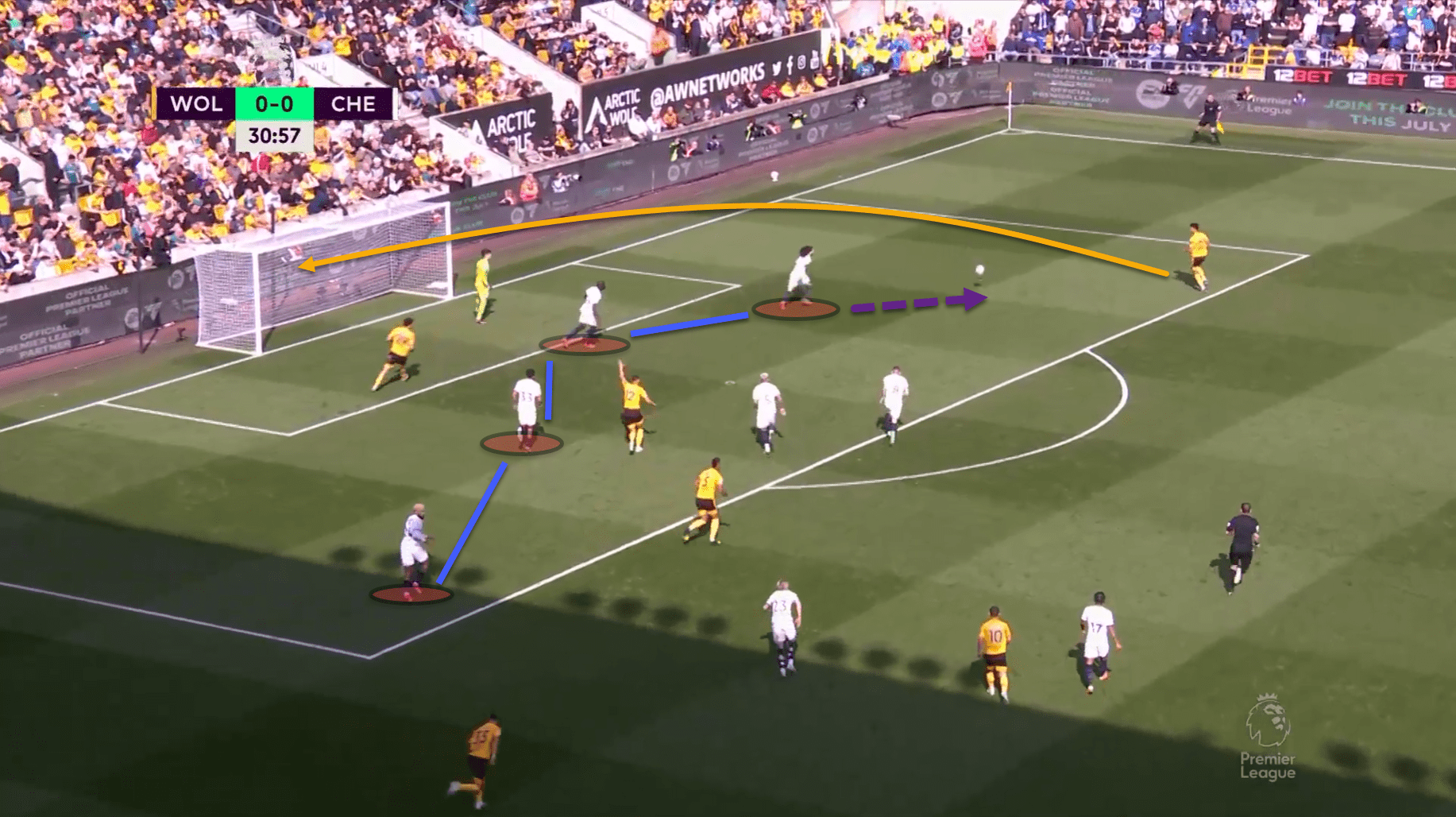 Marc Cucurella was forced to come inside to defend the back-post alongside Kalidou Koulibaly, leaving a lot of space behind him which Nunes exploited.
Marc Cucurella was forced to come inside to defend the back-post alongside Kalidou Koulibaly, leaving a lot of space behind him which Nunes exploited.
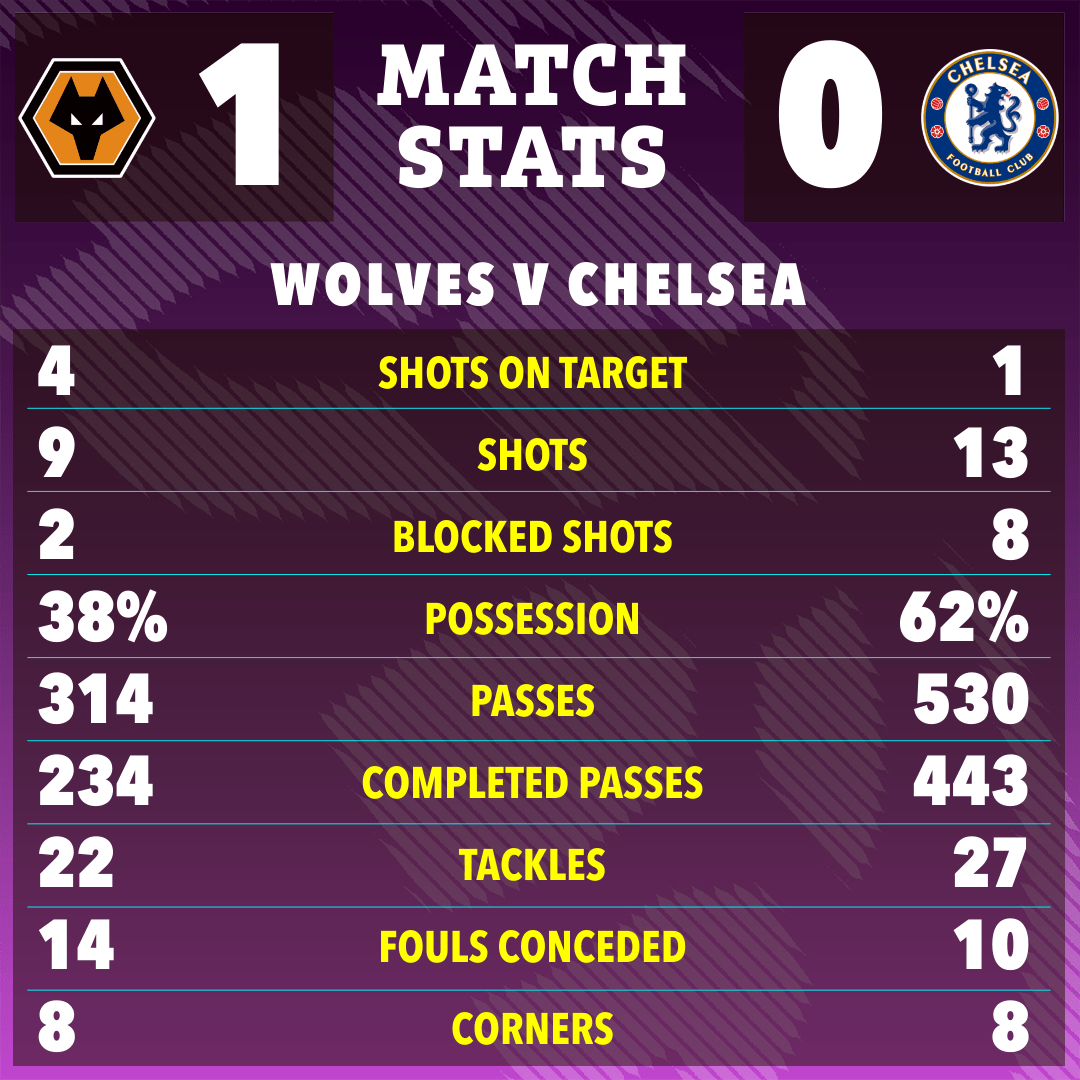 Chelsea dominated possession against Wolves but only managed one shot on target
Chelsea dominated possession against Wolves but only managed one shot on target
Defensively, a 3-4-3 shifts into a 5-4-1 formation. With an extra body at the back, Nunes would have been closed down quicker before unleashing his wonder-strike, possibly preventing the goal.
Now, with a trip to Madrid to come, many supporters fear that Lampard’s addiction to the 4-3-3 could lead to a harrowing night at the Estadio Santiago Bernabéu.
Overloading the fullbacks
Real Madrid have world class players in abundance, particularly in attack. They are the European champions after all.
However, despite playing for some incredibly conservative coaches in Italy before taking up management, Ancelotti has always been a little lenient with his offensive stars.
Players such as Vinicius Jr and Karim Benzema are given almost no defensive responsibilities for Los Blancos.
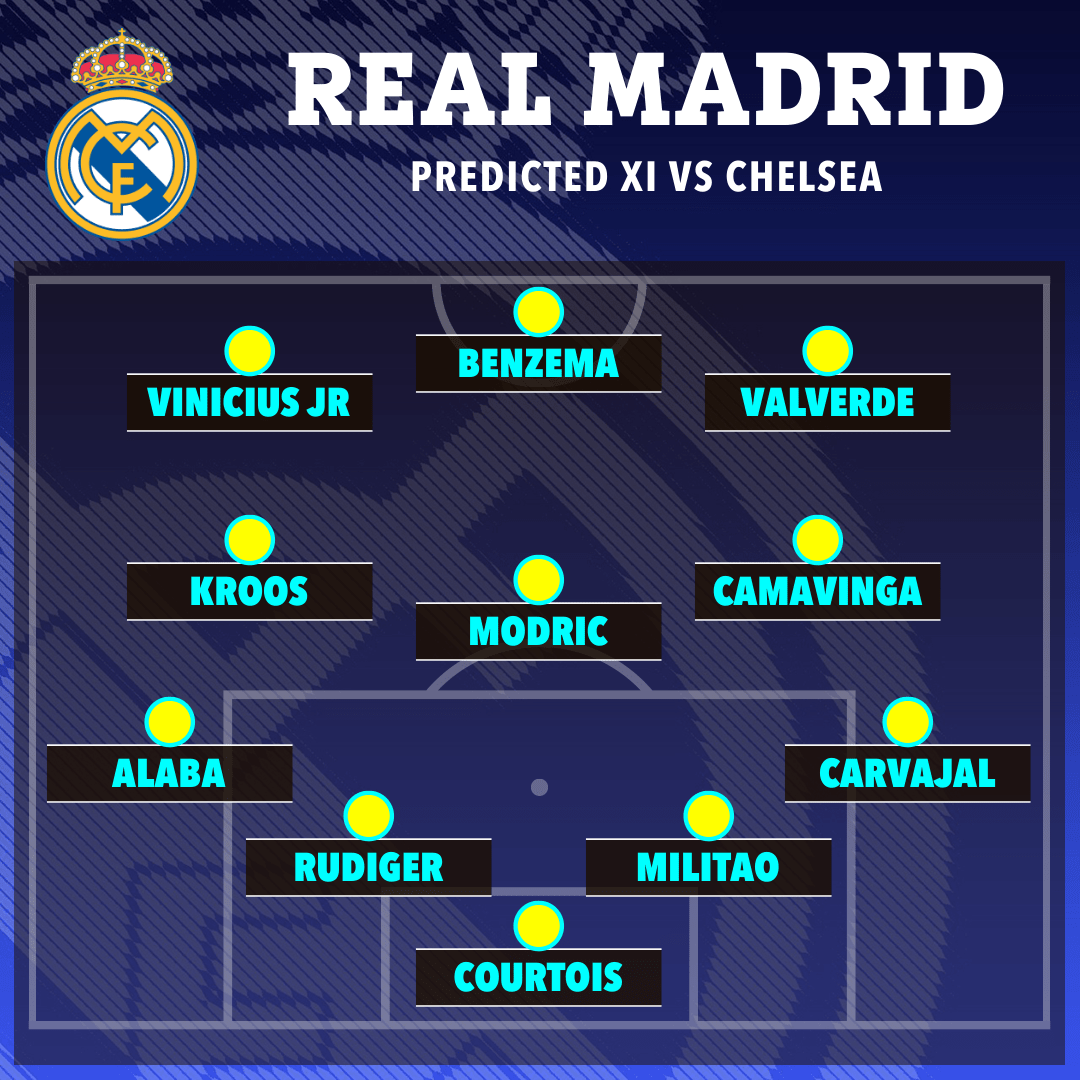 Real Madrid’s predicted team against Chelsea
Real Madrid’s predicted team against Chelsea
Against lesser opposition, this doesn’t stand out as much as when Real Madrid face teams that can match their quality.
For the most part, when sides defend in a 4-3-3, the wingers drop back, and the shape becomes a compact 4-5-1. Liverpool did this really well under Jurgen Klopp for many years.
Ancelotti doesn’t subscribe to this methodology. Real Madrid primarily defend in a 4-3-3 formation, but the wingers don’t track back.
As a result, the Spanish champions defend with a bank of four with their three central midfielders protecting the central areas in front.
Players like Vinicius Jr, Rodrygo and Benzema are kept further forward in case possession is turned over.
Their quality and pace is menacing on the break to exploit a disorganised defence.
But this leaves a lot of defensive imbalance for Real.
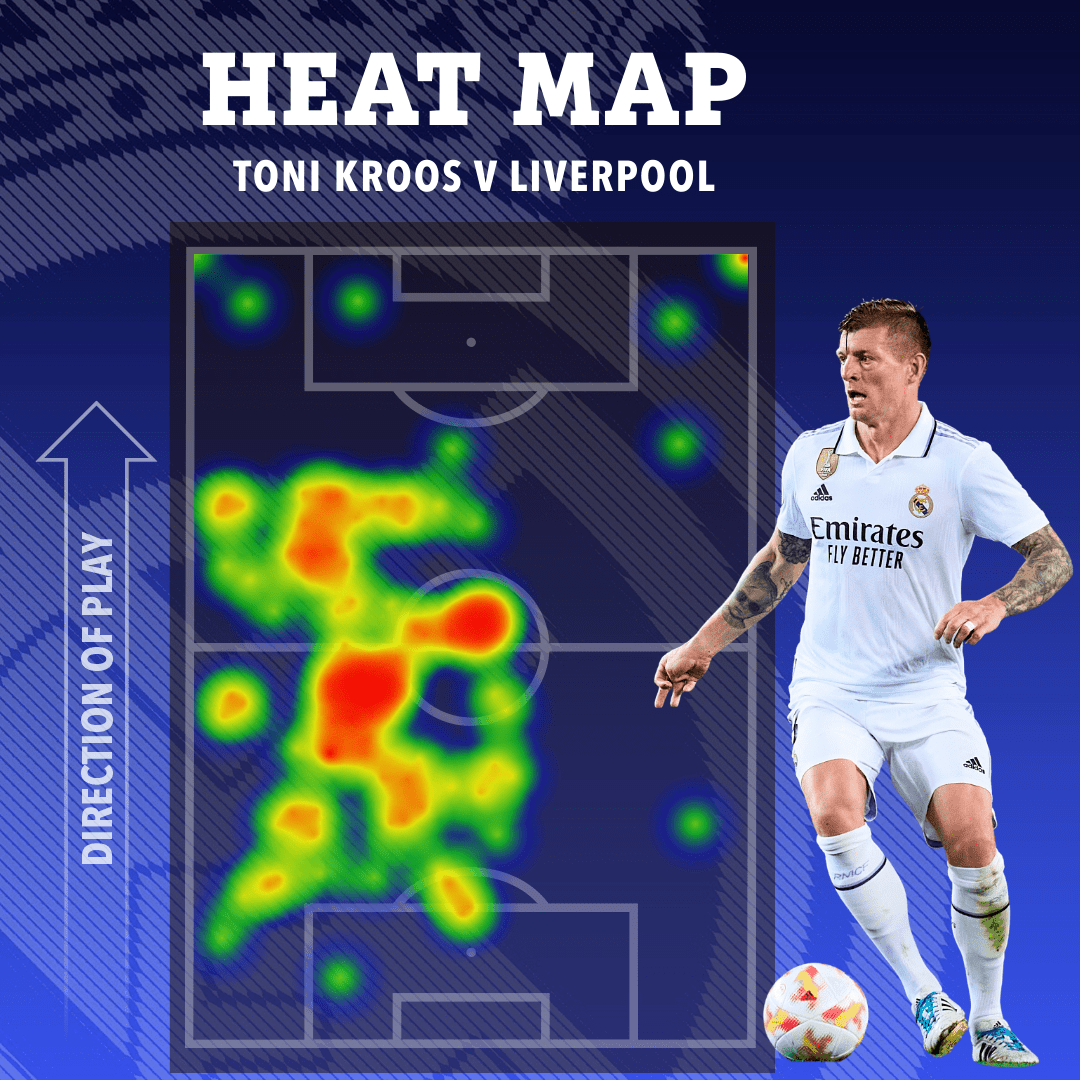 Toni Kroos remains a key man in midfield for Real Madrid
Toni Kroos remains a key man in midfield for Real Madrid
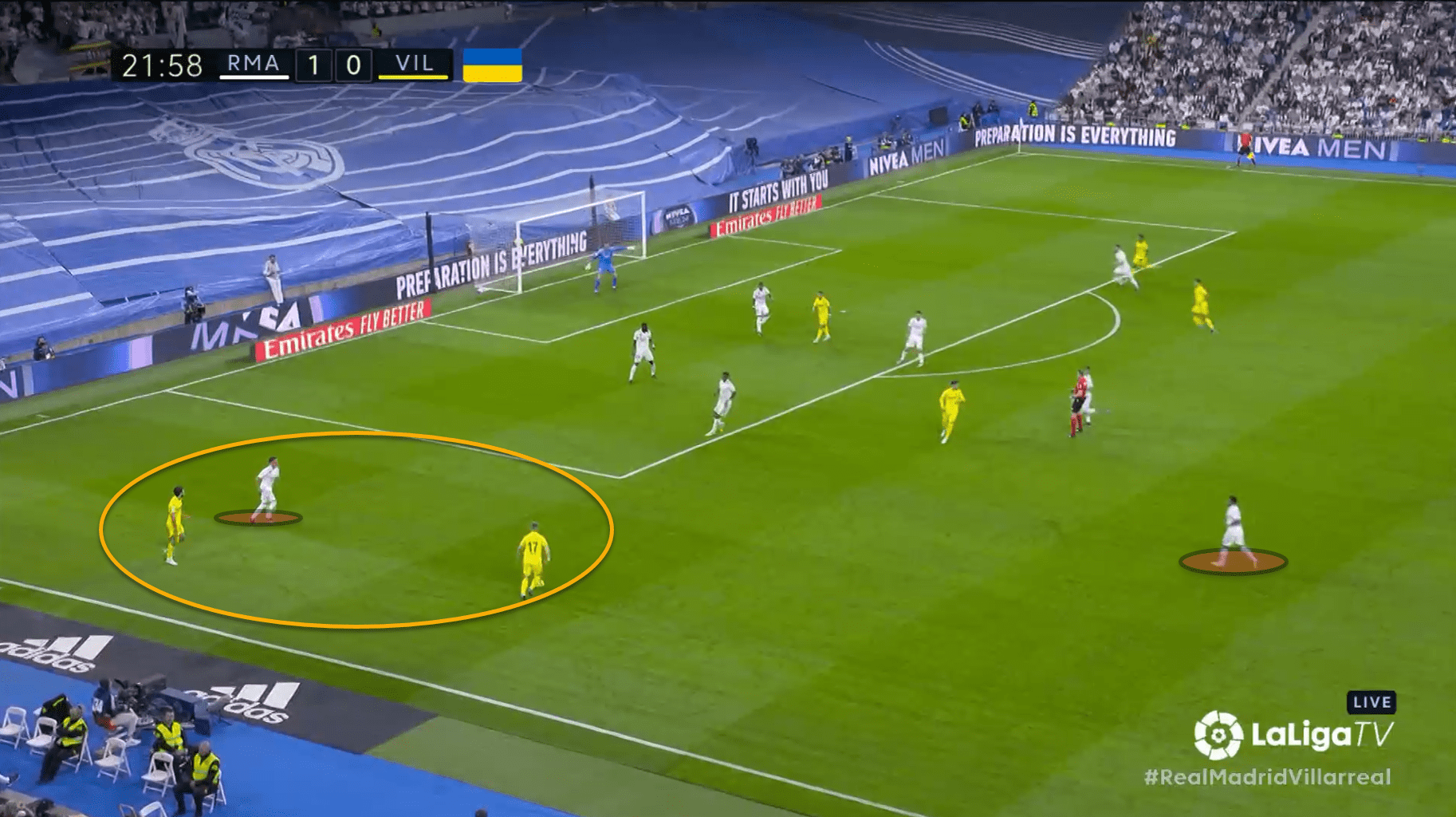 Real Madrid’s full backs can be left unprotected as the wingers often don’t track back
Real Madrid’s full backs can be left unprotected as the wingers often don’t track back
The fullbacks are often left isolated and can be overloaded 2v1 by the opposition’s winger and fullback.
Ancelotti’s side are currently conceding a goal a game which is quite high for a top side.
When analysing these goals, a lot come from overloads on their fullbacks as a result of the attackers not tracking back.
Since the fullbacks are outnumbered, normally the nearest centre-back is forced to come across and help them which leaves the defence very exposed in the box.
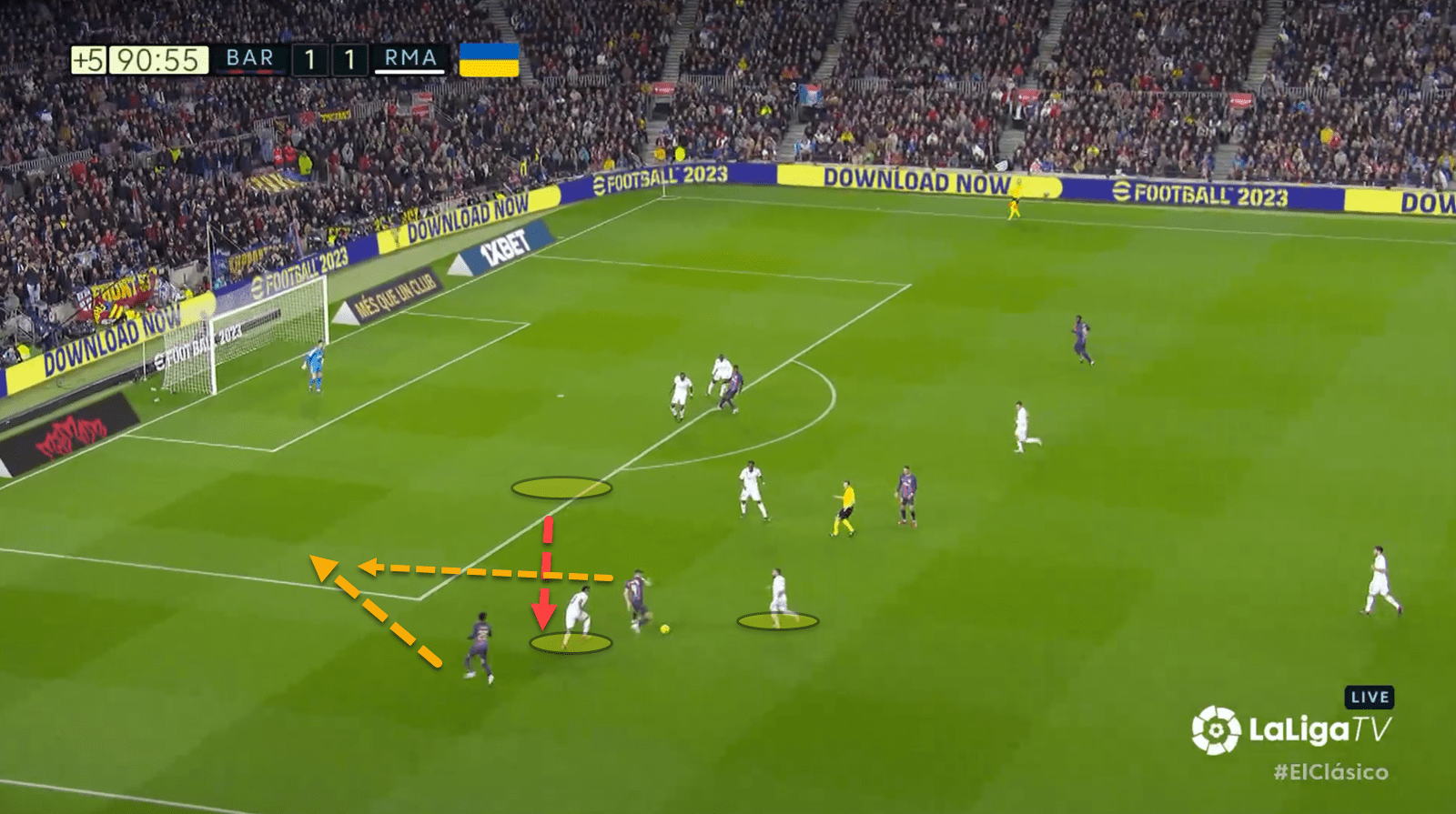 Robert Lewandowski has come across to create a 2v1 with left-back Alejandro Balde, causing Eder Militao to push over to help out and leaving just two to defend the box. Barcelona scored from this cross.
Robert Lewandowski has come across to create a 2v1 with left-back Alejandro Balde, causing Eder Militao to push over to help out and leaving just two to defend the box. Barcelona scored from this cross.
This is a weakness that Chelsea will surely look to take advantage of.
Regardless of whether Lampard deploys a 4-3-3 or a 3-4-3, the wide defender and the nearest winger can form overloads against Real Madrid’s fullbacks and create a lot of chances.
Whether Chelsea take their opportunities is a whole other issue.
Real Madrid’s lightning counterattacks
Real Madrid are excellent in possession, boasting players such as Luka Modric and Toni Kroos who are able to dictate the tempo of a match with their eyes closed.
However, the most dangerous part of Los Blancos’ play over the last ten years has been their threat on the break.
Real Madrid are the admirers of chaos and one of the best teams in Europe that thrive on disorganisation.
This was most notable throughout the side’s Champions League winning run last season in which they came alive during spells of games where tactics went out the window.
While leaving the front three very high and handing them little defensive responsibilities can cause a lot of issues at one end of the pitch, it has massive benefits at the other.
Real Madrid will sit back, soaking up pressure from the opposition, luring their players to come higher and higher up the pitch.
But once the ball is won back, and the opponent’s defence is exposed, you’ll struggle to find a team better in transition than Real.
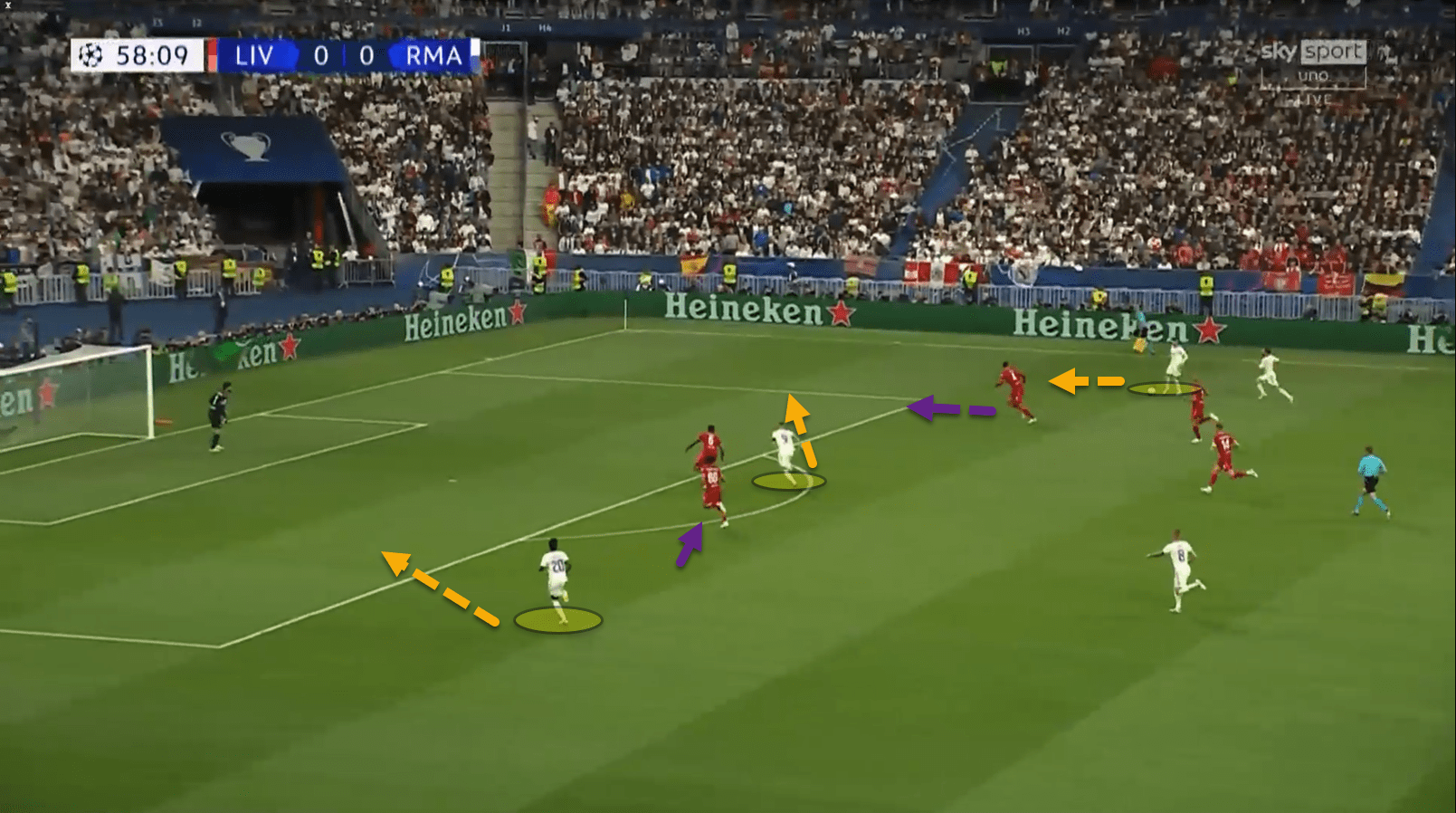 High fullbacks are the most common culprits of Real Madrid’s devastating counterattacks. Liverpool found this out more than any team in the Champions League final last season.
High fullbacks are the most common culprits of Real Madrid’s devastating counterattacks. Liverpool found this out more than any team in the Champions League final last season.
Benzema normally runs through the middle of the opposition’s centre-backs, causing the backline to narrow.
This allows the wingers to have more space down the sides to receive the ball and get into goalscoring positions.
It would be amiss to call Real Madrid a possession-based team and to claim that the hosts will dominate the ball upon Chelsea’s arrival in the Spanish capital.
The reality will be that the visitors could actually see quite a lot of the ball.
But Lampard must be careful with how risky his team are on the night or there could be serious repercussions.
Wolves didn’t create many transitional opportunities in Lampard’s first game back in the dugout but there was one moment in particular that rang alarm bells.
On this occasion, Chelsea got a little too giddy and piled far too many men forward in Wolves’ half.
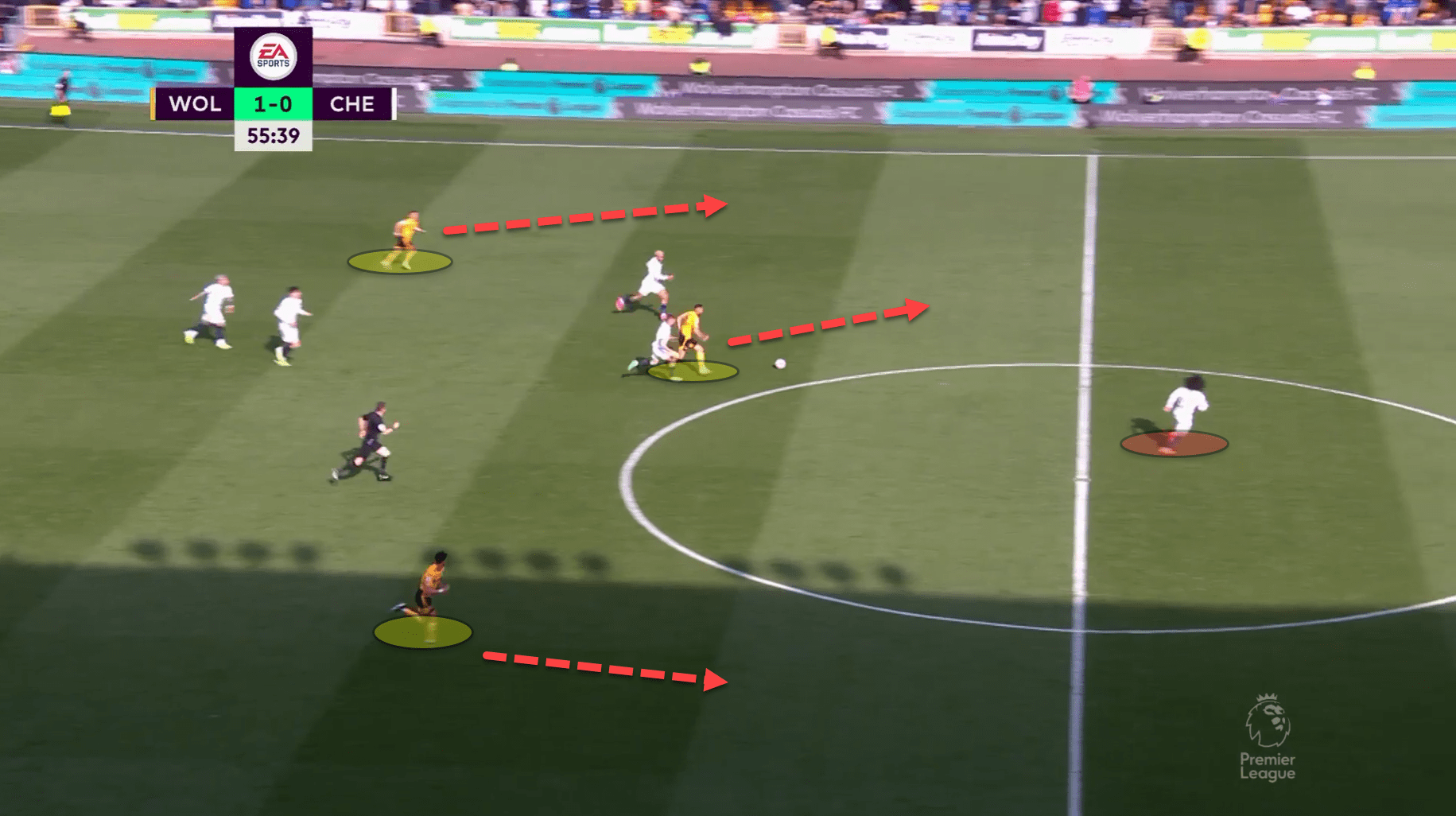 Having broken through the counterpress, the West London club were left in a sticky situation with Wolves runners coming from all directions against one man.
Having broken through the counterpress, the West London club were left in a sticky situation with Wolves runners coming from all directions against one man.
Luckily for Chelsea, nothing came from this chance, but Real Madrid will be less forgiving.
Lampard will need to concoct a way to ensure that Chelsea can still be a threat going forward in possession but are much more balanced defensively to protect themselves from Real Madrid’s counterattacks.
So what does this all mean?
It’s going to be a fun match.
Both teams are struggling in their own respective leagues, but the Champions League offers a breakaway from the hustle and bustle of league football.
Chelsea have been horrendous in front of goal this season while Real Madrid are certainly suspect defensively, making for a really fun match-up.
Lampard will need to ensure that the game stays organised if Chelsea are to have a chance of reaching the semi-final.
Should it descend into chaos, there will be only one winner.

